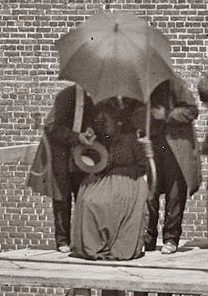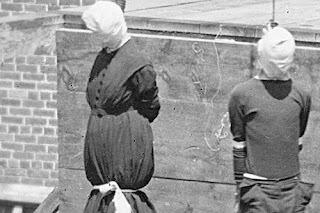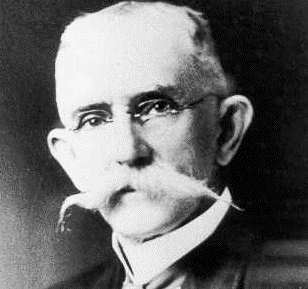The inscription in front of Marry Surratt's Boarding House at 604 H Street in Chinatown reads "The nest in which the egg was hatched." which are the words that President Andrew Johnson, used in April 1865 to describe this innocuous brick house just five blocks from at Ford’s Theater where President Abraham Lincoln was assassinated . Johnson was wrong; the house was never the site of any meetings between the conspirators, although John Wilkes Booth did visit the place several times directly before the murder.
Mary Surratt, was born Mary jenkins in Southern Maryland in the town of Waterloo and was educated in a private Roman Catholic girl's boarding school, the Academy for Young Ladies in Alexandria, Virginia. (Located on North Washington Street, the school eventually was Incorporated into Georgetown Visitation)
In 1839, she married 27 year old John Surratt in 1840. Surratt was reported to be a mean drunk (he essentially drank himself to death) who beat his 16 year old wife regularly. The couple had three children and tried a number of occupations over the next twenty years including a 287 acre tobacco farm, a general store, a gristmill, a tavern, and a post office. (There son John was the Postmaster of the Surrattsville station)
John died in 1862 and left Mary in debt. The family's slaves had either run away or been repossessed (it is unknown exactly what became of them), the sale of a substantial amount of property which had given hope of resolving the financial difficulties failed because of the buyers' default, and John's many creditors still pressed to collect. Mary leased the family farm and tavern to a former Washington, D.C., policeman named John M. Lloyd and moved into the District, into a house that she and her husband had owned, and turned it into a boarding house where her son John, a Confederate courier, lived along with several other co-conspirators in the Lincoln assassination.
Although living in the Union capital, she was quietly sympathetic to the Confederacy. Her older brother, Zadoc Jenkins, was arrested by Union forces for trying to prevent an occupying Federal soldier from voting in the Maryland elections that gave Lincoln a second term. Mary had a son fighting in the Rebels army. Another son, John, (who was born in the Congressional Heights District of DC and christened at St. Peter’s church) was good friends with John Wilkes Booth. Dr. Samuel Mudd introduced Surratt to Booth on December 23 1864.
At a meeting at the National Hotel in D.C., where Booth lived, (It was on Pennsylvania Avenue and is today the site of the Newseum) Surratt agreed to help Booth kidnap U.S. president Abraham Lincoln. The plan was to capture Lincoln, take him to Richmond, Virginia, and trade him for thousands of captured Confederate soldiers.
The plan was that on March 17, 1865, Surratt and Booth and others, would lie in wait for Lincoln's carriage when he left the Campbell General Hospital (Florida Avenue and 7th Street, was one of nearly three dozen military hospitals in Washington) and returned to Washington.
Their plans were foiled when Lincoln changed his mind and stayed in Washington to meet with the 140th Indiana Regiment and to present to the governor of Indiana a captured Confederate flag.
On the day of the assassination, Mary rode out to her tavern with one of her boarders, Louis J. Weichmann, a young War Department clerk, who was a friend of her son, John Surratt, Jr. Although Mary Surratt claimed to have made the journey to collect back rent owed by her tenant, John Lloyd, a former DC Policeman, later testified against her, saying she gave him a package containing field glasses and told him to "make ready the shooting irons." This referred to two repeating carbines and seven revolvers that she had bought and stored for the conspirators on her property. Mary admitted taking the package there but claimed that she did not know what the package contained.
After assassinating President Lincoln at Ford's Theatre, John Wilkes Booth did in fact first stop at the Surrattsville tavern with his accomplice David Herold. John Lloyd, the innkeeper, gave Booth and Herold whiskey, pistols, and one of two Spencer carbines as well as the field glasses. Lloyd claimed Surratt had told him to do this when she arrived earlier that day.
Three days after the assassination, April 18, police detectives came to interview Mrs. Surratt and by a very unlucky chance, Louis Powell, already identified as part of the plot, showed up while the police were there. Powell, a former member of John Mosby's Ranger, had attempted to assassinate Secretary of State William H. Seward. Powell’s sudden appearance was enough of a coincidence was enough for the authorities to implicate Surratt and arrest her. Mary Surratt denied ever having seen Powell before but several witnesses later testified Surratt had met Powell several times.
Mary was held in a makeshift cell on board a warship that was being used as a prison for the conspirators. Her cell was sparse and equipped with only a straw pallet and a bucket. Her head was covered n a padded canvas bag to prevent a suicide attempt. She was kept manacled and was constantly guarded by four soldiers.
Tried by a nine-member military commission beginning on May 9, 1865, Surratt was the oldest conspirator on trial and the only woman. She was defended by Reverdy Johnson, a onetime Maryland Senator from Annapolis and Attorney General of the United States under Millard Fillmore. In 1876, he would fall from a balcony at the Governor’s Mansion in Annapolis and was killed instantly.
Mary maintained her innocence throughout the trial, denying any knowledge of the assassination plot. The evidence against her presented by the prosecution included a hidden photograph of John Wilkes Booth found in her house and bullet molds on top of her dresser.
Still, the evidence against Mary Surratt is dubious. Weichmann was eventually released after he testified against her and later said that the government forced him to testify against Mary. He stuck to that story until the day he died. Lewis Powell, a conspirator who was hanged with Surratt, publicly stated she was innocent minutes before his execution. (The others hanged were David Herold, and George Atzerodt) Regardless, a military court convicted Surratt for her part in the conspiracy to assassinate Lincoln and condemned to death by hanging. President Andrew Johnson signed her death warrant
The trial continued until late June 30, when Surratt was sentenced to death by hanging for treason, conspiracy, and plotting murder, although the court attached to its finding a recommendation of commutation of her death sentence to life imprisonment, because of her sex and age.
At noon on July 6, Mary was informed she would be hanged the next day. The reports are that she wept profusely and then collapsed. A priest, her daughter Anna, and a few friends were allowed into see her but the guards insisted that she wear handcuffs, leg irons and a hood during the entire day before she was killed. She spent the night praying and refused breakfast and 10:00 AM, she was told to prepare for her death although her execution was delayed until the afternoon since most people expected, she would be pardoned by the President and soldiers were stationed on every block between the White House and the execution’s site to relay the expected pardon.
President Johnson later denied seeing the military judges' recommendation that Surratt's sentence be commuted to life imprisonment, but presiding Judge Joseph Holt said that Johnson read the recommendation and discussed it with him. Johnson, according to Holt, said in signing the death warrant that she had "kept the nest that hatched the egg”
She was hanged with three other conspirators at Fort McNair in Southwest DC on July 5, 1865. Several pieces of the rope that had ended Surratt's life and locks of her hair were sold as souvenirs. She was the first woman executed by the Federal government. The government’s policy during and after the civil war was to release female confederate spies and it more than likely that Mary was tried only as a means to force her son John out of hiding. Mary (and most of the others hung with her) were Roman Catholic and the speculation remains that the strong religious prejudice of the era contributed to rumors of a "Papist" conspiracy behind the assassination plot and the lack of Presidential clemency for Mary.
At 1:15 P.M., a procession, headed by the nearly fainting Mary Surratt, who wore a long black dress and black veil, and the other condemned prisoners were marched towards the east wall of Fort Lesley McNair in hand manacles and leg chains attached to a 75-pound iron balls. They were walked past their newly dug graves and marched up the thirteen steps to the ten-foot high gallows. Once there, Mary began to faint and had to be supported by two soldiers. The hangman had made Surratt's noose with five turns instead of the required seven because he had thought that the government would never hang a woman.
They were all seated in chairs while their chains and shoes were removed and their wrists were tied together behind them, their arms were bound to their sides, and their ankles and thighs tied together with a white cloth. Several members of the clergy stood nearby. Below them stood military personnel, various officials, and one hundred civilian spectators who had been issued tickets in order to be present to watch the convicted hang.
Powell stepped forward and yelled "Mrs. Surratt is innocent. She doesn't deserve to die with the rest of us". But he was pushed back with the others, nooses were placed around their necks, and thin white cotton hoods were placed over their heads.
Mary Surratt turned to her guard and said, “Please don't let me fall".
General Winfield Scott Hancock, who would later almost be elected President of the United States, read out the death sentences in alphabetical order. When he finished four soldiers knocked out the supporting post, releasing the platform. The conspirators dropped about five or six feet, which killed Herold and Atzerodt instantly, but failed to kill Powell and Surratt, who both slowly strangled to death over five minutes. Surratt was reported to have gagged and strained against her bonds as she died dangling in the noose. Their bodies were hung for 25 minutes, then unhooded and allowed to hang a further ten minutes before they were examined and pronounced dead.
Four years after the execution, the government gave Mary’s corpse to Anna Surratt who buried her mother in Mount Olivet Cemetery in D.C., (1300 Bladensburg Road, NE.) Her headstone reads “Mrs. Surratt". The body of John Lloyd, whose testimony may have sealed Mary's fate, is buried less than 100 yards away.
Mary's son John was captured after a year and a half as a fugitive, hiding in various Roman Catholic religious establishments as well as the Papal States. In September 1865, he traveled from St. Liboire to Montreal, to Quebec, and thence to Liverpool. He served for a brief time in the Papal Zouaves under the name John Watson.
Arrested in 1866, he escaped and travelled to the Kingdom of Italy, posing as a Canadian. He booked passage to Alexandria, Egypt, and was arrested there by American officials on November 23, 1866, then extradited to the United States. He was sent home on a U.S. naval warship and put on trial in a civilian court of the State of Maryland, instead of before a military commission. He denied any involvement with the plot, and claimed that at the time he was in Elmira, New York. Judge David Cartter, a former US Congressman from Ohio, presided over the trial which was hedl in DC . Surratts attorney wa Joseph H. Bradley (of 1517 Twenty-ninth-street) who hailed from an old and distinguised Washington-Georgia family.
John Surratt
John Surratt was released due to a mistrial and the statutes of limitations. The federal government attempted to retry him but was unsuccessful. In 1872 he married a second cousin of MaryVictorine Hunter, a second cousin to Francis Scott Key. He returned to Maryland tobacco farming and later taught at the Rockville Female Academy and St. Joseph Catholic School in Emmitsburg before serving as treasurer of the Old Bay Line steamship company, from where he retired in 1914. He died of pneumonia two years later at age 72. He died in 1916 and is buried in Baltimore.
An older John Surratt
Mary Surratt’s ghost has been sighted in several places, including the old Arsenal Penitentiary where she was hanged. Her body was temporarily buried (the bodies were placed on the coffins, which had been gun boxes) near the gallows before being move to permanent graves. Soldiers and their families swear to seeing a hooded figure wearing black, bound at the hands and feet, (She was buried with the hoods still on and a glass vial containing their names to help identify the bodies.) roaming about the grounds. Mary’s spirit has also been spotted at Surratt’s Clinton Maryland Tavern, on the stairs and on the first and second floors. Her apparition is reported to seen regularly at her DC Boarding House along with whispering and cried.
Mary Surratt's boarding house still stands and is listed on the National Register of Historic Places. The Surrattsville tavern and house are historical sites run by the Surratt Society located in Clinton, Maryland.








